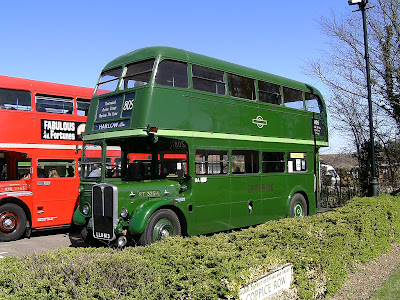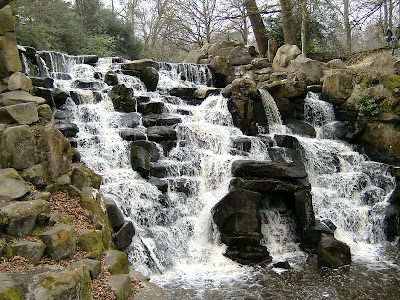23 April, 2013
20 April, 2013
Riding on top of the Bus
On a fine day red and green go so well together. So I went off to Theydon Bois for a ride on top of a bus. In fact I took two rides, one via Abridge and one via Loughton Station. The North London Transport Society had 'up to 20 vintage busses on display'. Actually there were about seven of which 3 or 4 were taking people for rides.
 This splendid Greenline bus used to ply its way to Harlow New Town of happy memory, and this is a South London Routemaster
This splendid Greenline bus used to ply its way to Harlow New Town of happy memory, and this is a South London Routemaster
 The routes were interesting going through Epping Forrest and the country towns of Essex. I enjoyed the leisurely rides on top of the vintage bus.
The routes were interesting going through Epping Forrest and the country towns of Essex. I enjoyed the leisurely rides on top of the vintage bus.
17 April, 2013
All aboard the Lady Daphne for Sea Change!
07 April, 2013
Carshalton House and its water tower
>
01 April, 2013
Windsor Great Park
The main use of Windsor Great Park is as a dog's toilet, judging by all the small bags left lying around. For today's excursion I had a book published by the Railway Executive in 1949 called Rambles in the Chiltern Country. After a brief moment of confusion as to which way was left on leaving Windsor and Eton Central Station (the author was wrong) I walked past the castle and into Park Street. The Queen was at home as shown by the Royal Standard flying and she had kindly arranged for the band of one of the Regiments of Guards to march through Windsor and play as I arrived. The music was wonderful on this cold and misty day. So the book took me down the Long Walk, 3 miles between the castle and the copper horse, and Windsor Castle's garden path. And of course the guide book led me up the garden path here by saying to take a path by the hospital. Well here was an Ozymandias moment: no trace survived of the hospital. Instead I walked up to the Copper Horse, a large mounted sculpture of Georgius Terto, Patri Optimus, Georgius Rex, which roughly translated means George III best dad King George. This was set up in 1831.
 As recommended by the guide book I took my lunch in the Fox and Hounds just outside the Bishop's Gate to the Park, and here I place on record that the chicken pie I had cost THREE times as much as the one I had in Kidderminster and was not as good.
I went back into the dogs toilet and walked down past another equestrian statue, this time of Prince Albert near the Guards Polo Club, walked through a little glade to Virginia Water. Somebody told me it was dug out by bored soldiers, who had come back from war with nothing to do. Sounds quite likely but not the official version. The lake is man made and has some embellishments like boat houses and picnic places. There are also some ruins from ancient roman cities on the African coast. These are built on each side of the main road with a tunnel to go through for viewing. These had become ruinous by the late twentieth century so they have recently been restored to their former ruinous state.
As recommended by the guide book I took my lunch in the Fox and Hounds just outside the Bishop's Gate to the Park, and here I place on record that the chicken pie I had cost THREE times as much as the one I had in Kidderminster and was not as good.
I went back into the dogs toilet and walked down past another equestrian statue, this time of Prince Albert near the Guards Polo Club, walked through a little glade to Virginia Water. Somebody told me it was dug out by bored soldiers, who had come back from war with nothing to do. Sounds quite likely but not the official version. The lake is man made and has some embellishments like boat houses and picnic places. There are also some ruins from ancient roman cities on the African coast. These are built on each side of the main road with a tunnel to go through for viewing. These had become ruinous by the late twentieth century so they have recently been restored to their former ruinous state.  There is also a spectacular cascade which is at the head of the lake, with people defying the instructions not to climb on it. As you can see it's a bit of a raging torrent.
There is also a spectacular cascade which is at the head of the lake, with people defying the instructions not to climb on it. As you can see it's a bit of a raging torrent.

The walk then took me past the totem pole, and the obelisk to the Duke Of Cumberland. The next part was to walk through the Rhododendron walk but these will not be in bloom until June. Instead I went to sit by the cow pond where there were substantial oak seats, a little bridge and a pergola. I negotiated the rhododendrons to get out and back up to the Bishop's Gate. This was a long wal so I had to decide whaat to do. I think that the railway decided for me in that there is now no Western Region Station at Staines. The official walk took me to Runnymede and I would have liked to go there but I would not haave been able to get home. Instead I walked in the sunshine back down the Long Wakl with Windsor Castle shining in the sun. No vehicles are permitted on the Long Walk but I did see some skilful driving on the long walk of a Tivo by someone who looked like Prince Phillip.
It was a long road home and I was glad to get in the train on the way back from Windsor.
 There is a video available on youtube.
There is a video available on youtube.
The walk then took me past the totem pole, and the obelisk to the Duke Of Cumberland. The next part was to walk through the Rhododendron walk but these will not be in bloom until June. Instead I went to sit by the cow pond where there were substantial oak seats, a little bridge and a pergola. I negotiated the rhododendrons to get out and back up to the Bishop's Gate. This was a long wal so I had to decide whaat to do. I think that the railway decided for me in that there is now no Western Region Station at Staines. The official walk took me to Runnymede and I would have liked to go there but I would not haave been able to get home. Instead I walked in the sunshine back down the Long Wakl with Windsor Castle shining in the sun. No vehicles are permitted on the Long Walk but I did see some skilful driving on the long walk of a Tivo by someone who looked like Prince Phillip.
It was a long road home and I was glad to get in the train on the way back from Windsor.
Subscribe to:
Posts (Atom)

